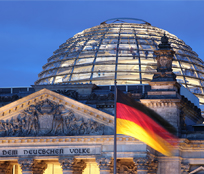Here we conclude our series of blog posts on the German federal election, which took place in late September (see our initial primer on the German federal election from June and our German federal election update from September). The new coalition’s policy program has been negotiated, approved and signed by all parties involved, the personnel roster is complete and the government has been confirmed by the Bundestag a few days ago. We take stock of this achievement and outline the daunting challenges awaiting the incoming government under new Chancellor Olaf Scholz.
The Coalition Treaty
The first three-party coalition at the federal level concluded policy negotiations strikingly quickly, which we interpret as a sign of shared convictions. That said, the negotiations were undoubtedly pressured by uncertainties around a resurging pandemic. Bridging the programmatic gap between the fiscally conservative FDP and the left-of-center Greens and SPD was made possible by a focus on green transition, as well as on using the modernization and digitization of Germany as overarching principles that move beyond traditional party priorities. In addition, there was a palpable sense of responsibility to not repeat the lengthy period of uncertainty after the previous elections in 2017.
From a macro perspective, we believe that accelerating the green transition by phasing out coal faster than previously planned while promoting renewables and natural gas will contribute to continuously higher (green) inflation. On the fiscal side, the treaty foresees a return to the constitutional debt brake for budgetary resources—a key concern for the FDP—but also provides space for public investment in infrastructure via (off-budget) state-owned enterprises and leverage of private initiatives via public development banks. The clear commitment by all coalition partners to a shared European financial responsibility—albeit relegated toward the end of the 178-page coalition treaty—will expand on work done already under Mr. Scholz while he was still Minister of Finance, including on a joint European deposit insurance scheme.
The Personnel Tableau
Aside from the welcome gender parity around the cabinet table, the markets’ focus rests in particular on the new finance minister given the position’s pivotal domestic and international role. With incumbent Scholz moving to the Chancellery, the (designated) new minister is Christian Lindner, leader of the smallest coalition partner, the FDP. Given the party’s ordoliberal roots, we expect Lindner to act in budget discussions as a (moderate) counterweight to the spending ministries, especially those headed by his cabinet colleagues from the Greens and the SPD. We expect Lindner to also play a moderating role when the discussion comes to the relaxation or even circumvention of fiscal rules, both at a national and at a European level.
Another interesting appointment is Karl Lauterbach to the position of health minister. Lauterbach is a trained MD with an additional degree in epidemiology as well as public health policy and management. He seems well-equipped to face the challenging task of seeing Germany’s weakened health system through future Covid waves while increasing the country’s vaccination rate, which has been lagging those of many other European nations.
One pending personnel decision watched closely by markets is the appointment of a new Bundesbank president; there could be a significant change in tone given that Jens Weidmann had been perceived as a key representative of the hawkish side of the spectrum.
Next Steps and Policy Priorities
While the longer-term policy themes will take time to implement, the coalition will have to hit the ground running after 10 weeks of post-election lull. On the domestic side, we expect the new government to tackle the recent pandemic developments and especially vaccination rates more forcefully than Angela Merkel’s caretaker team could. Lauterbach’s strong public profile should help in this context. Moreover, with inflation at 30-year highs driven by energy prices, the government will have to act quickly to lessen the pressure on lower-income households, including by raising the minimum wage. On the international side, the most urgent agenda items include a reassessment of the relationship with Russia and the future of the Nord Stream 2 pipeline in light of the situations in Ukraine and Belarus. At the European level, the German government has a bit more time as critical elections will unfold over the next few months in two other key European countries: France and Italy. Key European topics including revisions to the Stability and Growth Pact will have to wait until 2H22, but the technical work should be done ahead of time—especially if those new rules are meant to be binding for the 2023 budget cycle across the EU.
Market Implications
The flare-up in risk aversion due to a renewed risk of lockdowns even before the omicron variant appeared, combined with technical year-end factors, has pushed yields on German government bonds back deeper into negative territory. We view this as another opportunity to position for rising yields over the medium term because the ECB is likely to reduce its purchases in 2022 as the rebound continues. While pandemic-related spending will abate, pressures from the green transition are only beginning. From a supply perspective, EU issuance will continue at a fast pace for several years in light of the European recovery fund, increasing the amount of high-quality sovereign and supranational bonds, thereby reducing the attractiveness of holding bunds.



